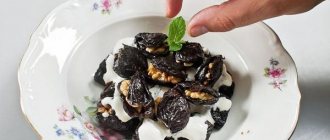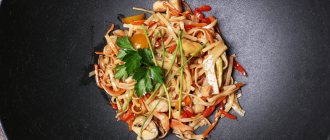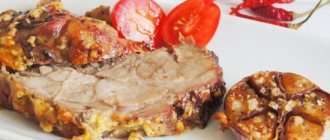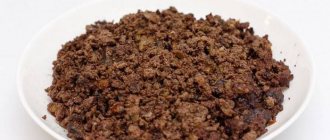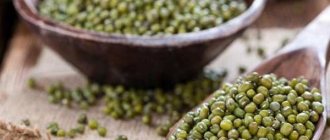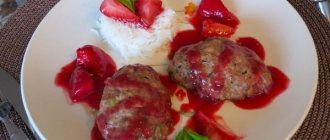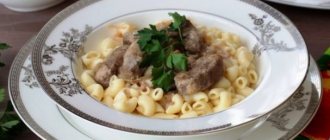Chicken noodle soup
A light and tasty dish suitable for both dietary and everyday meals. Cooking chicken noodle soup is quite simple; it does not require any special knowledge or skills; even a beginner can do it.
Ingredients for 5-6 servings:
- small chicken carcass - 1 pc.;
- durum wheat vermicelli - 6 handfuls (slightly less than half a package weighing 450 g);
- onion - 1 head;
- carrots - 1 pc.;
- dill and parsley - 2-3 sprigs each;
- vegetable oil - 1 tbsp. l.;
- salt pepper;
- water (about 3 liters).
Cooking method:
- First you need to cook the broth. To do this, place the chicken in a large saucepan, add water so that the carcass is covered by about 4 inches, put it on the stove, wait until the broth boils, then reduce the intensity of the heat: the soup should boil, but not too much. Cook for 40 to 60 minutes, skimming regularly and making sure the broth does not boil over, otherwise it will become cloudy. Add salt and pepper to taste shortly before the end of cooking.
- While the broth is boiling, prepare the remaining ingredients: finely chop the onion, grate the carrots on a coarse grater or cut into thin and short strips, chop the greens.
- Remove the cooked chicken from the pan and place on a plate, then strain the broth. A sieve is suitable for this; if you don’t have one, you can use clean gauze.
- After filtering, you need to estimate the resulting volume of liquid. If it is not enough, then add boiled water to the required amount. In any case, the broth will be strong, so adding water will not harm its taste.
- Place the strained and diluted broth on the fire and bring to a boil again.
- While the future soup is boiling, fry the carrots and onions. To do this, add oil to the pan and add vegetables. Saute them over low heat until cooked: the onions should become transparent and golden, and the carrots should be soft. It is worth considering that grated carrots cook faster than chopped carrots, so the second option requires a little more time for frying. In this case, the carrots can be sent to the pan first, and after a few minutes add the onions.
- As soon as the broth boils, add fried vegetables and vermicelli. You should cook it no more than the time indicated on the package (usually 8 minutes), then turn off the soup, but do not cover it with a lid, otherwise the noodles will swell more than required.
When serving, the cooked chicken should be cut, the meat should be chopped, and a small amount should be placed on the bottom of each plate, then pour in the chicken noodle soup and sprinkle with herbs.
What is the difference between vermicelli and other similar Italian pasta?
Italians have a lot of round thin pasta. If you don’t get attached to the length, this value is still not very constant; the main difference is the cross-sectional diameter. There are standards for it.
- Vermicelli should have a diameter of 2.08 to 2.30 mm, depending on the manufacturer.
- Spaghetti – diameter from 1.92 to 2.00 mm.
- Vermicellini, vermicellini (“thin vermicelli”) - diameter from 1.75 to 1.80 mm.
- Fidelini, fidelini – diameter from 1.37 to 1.47 mm.
- Capellini, capellini (or capelli d'angelo - “angel hair”) - diameter from 0.8 to 0.9 mm.
Fried vermicelli (without cooking)
This is an incredibly fast and, most importantly, delicious way to prepare pasta. It will require:
- vermicelli from durum wheat - approximately 150 g (one third of the package);
- vegetable oil - 50 ml;
- salt to taste;
- water - a little more than a glass (you can use weak broth).
Cooking method:
- Place the frying pan on the fire, add vegetable oil and heat.
- Add the vermicelli and fry, stirring constantly, until the pasta turns golden brown.
- After obtaining the desired color of noodles, pour water into the frying pan, add salt to taste, and mix thoroughly.
- Reduce heat to moderate and wait until all the water has boiled away.
The vermicelli fried in a frying pan is ready and can be served as a separate dish or as a side dish.
When did vermicelli appear in Italy?
In Italy of the 14th century. long pasta had different local names. In 1338, the work Compendium de naturis et proprietatibus alimentorum (“Brief information on the nature and properties of food”) was published and there “vermicelli” is called “orati” in Bologna, “fermentini” in Reggio and “pancardelle” in Mantua.
The first mention of a recipe for vermicelli is contained in the book De arte Coquinaria per vermicelli e maccaroni siciliani (“The Art of Cooking Sicilian Pasta and Vermicelli”). It was written by the famous cook Martino de Rossi (or Martino da Como) presumably from 1456 to 1467. At that time he had no equal chefs and, perhaps, he was the first famous chef in Europe, about whom people talked not only at the table and in his kitchen - a kind of Gordon Ramsay of the 15th century.
Libro de arte coquinaria has several recipes for vermicelli, which can be stored for 2 or 3 years if it has been dried in the sun. In fact, Maestro Martino is considered the first to seriously study vermicelli and recipes made from it.
Italian vermicelli
Vermicelli pilaf
Is that possible? It turns out yes. At the same time, the dish looks like real pilaf and turns out very tasty.
What you will need to prepare pilaf with vermicelli:
- chicken fillet - 500 g;
- vermicelli - 1 package (400–450 g);
- onions - 3-4 heads;
- large carrots - 2 pcs.;
- all-purpose seasoning (a mixture of herbs and spices);
- garlic - 2 cloves;
- salt pepper;
- vegetable oil - 50 ml;
- water - 450 ml;
- any greens - optional.
Cooking method:
- Cut the chicken into cubes.
- Peel and chop the onion.
- Also peel and grate the carrots for Korean salad or cut into thin and narrow strips.
- Pour vegetable oil into a cauldron, heat it, and place the chicken in it. Fry it until the excess liquid boils away over moderate heat under the lid. In time it is approximately 5–7 minutes.
- After the liquid has evaporated, salt the chicken, add carrots and onions, and fry until cooked. This will take about 7 minutes.
- As soon as the chicken and vegetables are ready, add vermicelli to the cauldron and mix thoroughly, fry for 3 minutes.
- Pour in 450 ml of hot water (boiling water), stir.
- Add 2 cloves of finely chopped garlic, salt and pepper, mix.
- Cover with a lid, reduce heat to low and simmer for 5 minutes.
- After the specified time has expired, the cauldron must be removed from the heat and set aside for another 7 minutes.
- Open the lid, stir and serve, garnishing with chopped herbs if desired.
How to fry vermicelli: recipe in a frying pan
Ingredients
- Raw vermicelli from durum wheat – 300 g;
- Butter – 30 g;
- Water – 3 glasses.
How to cook vermicelli in a frying pan
Fried vermicelli prepared according to this recipe is simply irresistible to your family: it is usually “swept up” in a matter of minutes! It is not only tasty, but also positively bright: each vermicelli has its own shade! To prepare multi-colored noodles, follow this plan:
- Melt the butter in a non-stick frying pan over medium heat.
- Add the pasta and, without reducing the heat, fry the vermicelli, remembering to stir all the time. It should take on a golden hue.
Do not overcook vermicelli until brown, otherwise it will acquire a burnt taste!
- Add one and a half glasses of water to the frying pan and, stirring the product all the time, cook it until the water has evaporated almost completely. Pour in the same amount of water again, add salt and mix.
- When the water has evaporated, the dish is ready. Try the vermicelli while cooking: if it is a little hard and the water will run out soon, add a little more water and cover the pan with a lid.
Transfer the finished dish to plates and place on the table. You can serve noodles with hot or mild sauce, meat, fish, vegetable salad, seafood, etc. Your loved ones will definitely love this colorful dish with a delicate creamy taste!
Vermicelli casserole
It may not sound very appetizing, but it turns out simply incredibly tasty. Those who are tired of monotonous food will make a real discovery for themselves by trying this casserole. In this dish, vermicelli reveals itself from a completely unfamiliar, but surprising side.
Ingredients:
- vermicelli - 200 g (half a standard package);
- medium-sized sweet apples - 2 pcs.;
- dried apricots - 150 g;
- large chicken eggs - 2 pcs.;
- granulated sugar - 2 tbsp. l.;
- water - 1.4 l;
- salt - to taste;
- butter - 50 g;
- sour cream, jam or preserves (optional for serving) – 150 g.
How to cook:
- Cook the vermicelli according to the instructions on the package, drain in a colander, and rinse.
- Place dried apricots in warm water for a few minutes until they become soft, then place on a napkin to dry, then chop.
- Peel the apples, remove the core, cut into small cubes.
- Beat eggs (whites and yolks together) with a mixer or fork with added sugar to form a strong foam.
- Prepare the pan: cover it with parchment paper, which needs to be greased with butter.
- Mix pasta, fruit, beaten eggs, pour the mixture into the mold.
- Place the casserole in an oven preheated to 180°C and bake until golden brown.
- Remove the pan from the oven, remove the casserole, let cool slightly, cut into portions and serve with sour cream, jam or preserves.
Vermicelli from Italy to Mexico via Asia and the Middle East
There are two main types of vermicelli: Italian (simply "vermicelli") and Asian (also known as "rice vermicelli" and "glass vermicelli"). But there are other countries and parts of the world where vermicelli and recipes involving it occupy an important place in local cuisine.
Italian vermicelli
Connoisseurs of Italian cuisine believe that vermicelli, one of the oldest forms of pasta, first appeared in Campania. In Naples, the capital of this region, Neapolitan pasta was once called "vermicellari". It was made by hand, was shorter and not so straight. Most likely, this paste was more like “little worms” back then than it is now! At the same time, there are mentions of vermishelsh in Hebrew texts of the 11th century. Vermicelli may indeed be one of the oldest forms of pasta.
Italian vermicelli is made from durum wheat flour and can be used like any other fine pasta, especially spaghetti, spaghettini or angel hair; what distinguishes them from each other is the degree of “thinness” (read more about this below).
Italian vermicelli arranged in a nest shape
Rice-A-Roni, a treat from San Francisco
Italian vermicelli is used to prepare the famous US dish Rice-A-Roni , which after World War II was called “a treat from San Francisco.” Newlyweds Lois and Tom De Domenico (he from Italy, she from Canada) moved to San Francisco in 1946, where Tom’s father owned a pasta factory, and rented a small apartment from an Armenian family. Mrs. Kaptanian took Lois's culinary patronage and taught her how to cook baklava and signature Armenian pilaf. Tom brought vermicelli from the factory, which the women crushed finely to make it look like grains of rice. Later, when Armenian pilaf made from rice and noodles took root in the De Domenico family and became their favorite dish, Tom, after a long day of work, wished: “How great it would be if pilaf was sold in boxes - almost ready.” It took 3-4 years to adapt the recipe to the family production. They decided to call the dish Rice-A-Roni (“rice and pasta”). In 1955, there weren't many packaged side dishes on the market, so the noodle and rice dish became one of the first popular fast food items. To this day, colorful boxes of Rice-A-Roni are sold in the United States and the dish is popular not only in San Francisco.
Mrs. Kaptaniani's rice pilaf recipe has been passed down through the De Domenico family, so the mushrooms and pine nuts may have been introduced into the recipe over time.
- In a frying pan with high sides, fry long grain rice and chopped vermicelli with butter (1:7, in favor of rice) until the vermicelli is light golden brown.
- Add finely chopped onion, mushrooms such as champignons and a small handful of pine nuts. Stirring, continue cooking over medium heat, 3-5 minutes.
- Pour chicken broth over the fried ingredients and add salt.
- Cover the pan with a lid and cook for 30-35 minutes without removing it.
- Remove the pan from the heat, open the lid and fluff the contents of the pan with a fork. Cool slightly and serve.
Homemade Rice-A-Roni
Frittata, Italian omelette
In Italy, among other noodle dishes, they like to cook pasta frittata. The word frittata comes from the verb friggere, which means to fry. The dish can be prepared with other Italian pasta, but crispy vermicelli is perhaps the most delicious. This noodle recipe is a way to use up leftover pasta. Italians used to use both leftover plain pasta and leftover pasta already mixed with sauce. Over time, the dish has become so popular that it is only prepared from leftovers when necessary, and many people specially cook the pasta the day before in order to prepare a frittata the next day. We have a wonderful frittata recipe from the south of Italy - from Basilicata.
- Boil the vermicelli until al dente, drain in a sieve and let cool in a bowl.
- Fry the coarsely chopped anchovies and garlic, plus chilli flakes, in olive oil until the anchovies begin to melt. No need to fry the garlic!
- Transfer the contents of the frying pan into a bowl with the cooled noodles, add beaten eggs (7-8 eggs are needed for 250-300 g of finished noodles).
- Salt, pepper, add a handful of finely chopped parsley.
- Stir and pour the mixture into a large preheated frying pan, preferably with a non-stick coating. Fry until golden brown and crispy on both sides. Serve the vermicelli frittata hot.
Frittata pasta, one of the serving options
Asian rice vermicelli
Asian vermicelli noodles are not called that in Asia - in the countries where they are produced and where they are eaten. In fact, it has many names depending on the country of origin. In Europe and the USA, it received this nickname due to its shape, similar to Italian vermicelli. Asian vermicelli is prepared from rice flour.
Rice vermicelli makes a great base for super fresh and super healthy Vietnamese salads. They can be eaten chilled or at room temperature with BBQ pork, grilled shrimp, or fried or baked peanut tofu. Each variation of the salad is complemented by crunchy carrots and bean sprouts, and a variety of herbs - basil, mint and cilantro. The best dressing is spicy-sweet-sour-salty, prepared on the basis of hot nuoc cham sauce (the base of which is fish sauce, garlic and lime juice).
Unforgettable Asian rice vermicelli soup
Rice vermicelli can be prepared in just 15 minutes. Asian soup with a magnificent orange hue, inviting aroma and incredible taste. It might even make the perfect weeknight dinner.
- In a frying pan with high sides over medium heat, stir-fry red curry paste, chopped fresh ginger root, garlic with vegetable oil, 4-5 minutes.
- Add chicken pieces, maybe breasts, and continue cooking until the chicken changes color.
- Add chicken broth, fish sauce and coconut milk. If desired, dilute the liquid mixture with drinking water. Boil until the chicken is done.
- Place rice vermicelli in bowls and pour boiling soup over it. Stir, season with lime juice and chopped cilantro. Leave for a couple of minutes until the vermicelli is ready and serve hot.
Asian soup in 15 minutes. with rice vermicelli and shrimp (instead of chicken)
Asian starch vermicelli
Glass noodles are a type of Asian vermicelli. It is made from mung bean starch (Asian beans or mung beans, as these legumes are also called) or sweet potato starch (yam). It is transparent, very thin and moderately long. The texture of glass vermicelli is slightly softer and more gel-like compared to rice vermicelli. It is gluten free! Thin and short glass vermicelli can most often be found in Vietnamese spring rolls and banh bao steamed buns.
In Korean cuisine, there is a dish called “japchae”, which uses danmyeon vermicelli, made from sweet potato starch. These noodles are said to “have the coolest chewy, almost rubbery texture that makes eating any bowl of noodles 10 times more exciting.” The dish is prepared quickly and simply from glass noodles with the addition of sesame seeds, rice vinegar, garlic, fresh ginger root and seasonal vegetables and/or mushrooms. A mandatory ingredient in the dish is the Korean seasoning gochujang (a spicy paste made from fermented soybeans, glutinous rice and red hot pepper).
Japchae with vegetables
Vermicelli in the Middle East, India and East Africa
In Egypt, vermicelli is fried with vegetable or butter and then boiled along with rice. In Somalia, qadriad is made from vermicelli. For it, vermicelli is fried in butter, water, sugar and cardamom are added and brought to full readiness. This dish is usually eaten as a dessert or served as a side dish with rice dishes. Qadriad is also a common dessert in some parts of Ethiopia, especially influenced by the Arabs. There the dish is known as "attriya" and it is served cold, often with a thin layer of custard on top.
But the most unusual use of vermicelli is in falooda, a layered dessert in a glass/glass that originated in Persia. It is also remarkable for its variety of textures. The dessert is now prepared in India, Pakistan, almost everywhere in the Middle East, Bangladesh and Turkey. The Persians who migrated to India from Iran introduced this sweet mixture to the Indians. It has become an integral part of street trading. A similar drink, but with thicker noodles, is drunk by Kurds in Iraq.
The basic recipe for a milk dessert in India consists of rose syrup, cornflour or arrowroot vermicelli (a starchy flour obtained from the rhizomes and tubers of tropical plants), milk and ice cream. The base can be supplemented with saffron, mango, pistachios, jelly cubes, strawberries, chocolate, chia seeds.
Falooda, layered dessert in a glass/glass, one of the serving options
Mexican vermicelli
Mexican fideos, which means "noodles" in Spanish, are very similar to Italian noodles in shape and ingredients. It is also prepared from wheat and water, but is always extremely short. It is often fried in oil for a richer flavor rather than boiled. Mexican dishes with fideos can be prepared with the usual vermicelli. For example, Fideo Seco soup, which is prepared in almost every Mexican home. This recipe originated around 1890, when Italian emigrants arrived in the country and brought with them their national cuisine.
The soup is prepared almost like a classic marinara sauce. It is based on: tomatoes, onions, garlic, herbs plus water/chicken broth and fideos. Vermicelli is fried until crunchy and golden brown with vegetable oil. And then they add tomato broth, sometimes adding pieces of chicken and very often chili pepper or chipotle (smoked red jalapeno). The soup is served with avocado, local young cheese, cilantro leaves and lime wedges. Mexicans like to serve this soup “dry”, in the form of a thick mass with tortillas or nachos. They even make tacos with it and call this dish “carbohydrates on carbs.”
Fideos in the “dry” version
Our – Russian – vermicelli
The first pasta factory in Tsarist Russia appeared in Odessa in 1797 (according to another version - in 1802). The Italians who lived in Odessa, and Joseph Mikhailovich Deribas himself (aka Jose de Ribas) , the founder of the city and port of Hadzhibey, later renamed Odessa, strongly supported the idea of a new production. In addition, in Odessa there was enough sun for natural drying of products, and they were prepared according to Neapolitan customs: during the day the pasta was dried in the air, and after sunset it was put under the roof. Such drying lasted up to a week - drying machines had not yet been invented.
In our country, vermicelli is classified as a thread-like product. Vermicelli is most often produced in the form of threads of different lengths and cross-sections. The length of short vermicelli is at least 1.5 cm, long vermicelli is at least 20 cm. The product can be laid in the form of a skein or nest.
Our vermicelli can be divided into varieties:
- “extra”, prepared from semolina flour (fine flour),
- “extra egg” – made from semolina flour with the addition of yolk or melange (egg mixture made from white and yolk),
- “superior” – made from premium flour,
- “first” – made from 1st grade flour.
Vermicelli casserole (lapshevnik), see the recipe for one of the options here
Fkusnofacts
— Calorie content
vermicelli in a frying pan - 250 kcal/100 grams.
To measure
the required amount of noodles, use a kitchen scale or a regular 250 milliliter mug. Pour the vermicelli into the mug, filling it to the brim - this will measure out 250 grams of vermicelli.
To prepare fried vermicelli, it is recommended to use
deep frying pan with non-stick coating or wok (round deep Chinese frying pan).
Vermicelli contains many beneficial
substances for the body. B vitamins and amino acids have a positive effect on the functioning of the digestive and intestinal systems.
Fried vermicelli can be served
as an independent dish (if you add cheese, mushrooms and/or an egg when frying) or a side dish for poultry, fish or meat. It can be prepared for cutlets, roasts, French meat or baked carp.
— Shelf life
fried vermicelli - 2 days. It should be stored in a closed container (frying pan, saucepan, plate under cling film) in the refrigerator. When raw, vermicelli is recommended to be stored in a dry, clean place in accordance with the shelf life indicated on the product packaging (approximately six months to a year).
— Cost
vermicelli - from 45 rub.
per 450 grams (Moscow average as of June 2017). — In the process of preparing fried vermicelli, you can use various spices
to give the noodles a special shade and aroma: turmeric - gives a rich yellow color and a light spicy smell; marjoram – a spicy, pronounced taste. Can replace pepper; garlic granules - for a pungent fragrant aroma and rich taste; hops-suneli - gives a characteristic taste and bright oriental aroma.
Fried vermicelli goes well
with spicy types of sauces (Tobasco, mustard, chili, adjika) and with gentle ones (sour cream, tartar, Burgundy).
On the one hand, everyone knows how to cook vermicelli - the product just needs to be placed in salted boiling water and removed after the number of minutes indicated on the package. On the other hand, ignorance of the nuances of the process will lead to the elements of the product sticking together, regardless of whether it is boiled in a slow cooker or a saucepan. But if you do everything correctly, you can count on getting not just a pleasant-tasting side dish, but a rather exquisite dish with a delicate texture. In addition, small and fragile paste is often added to soups and used to create children's milk porridges.
